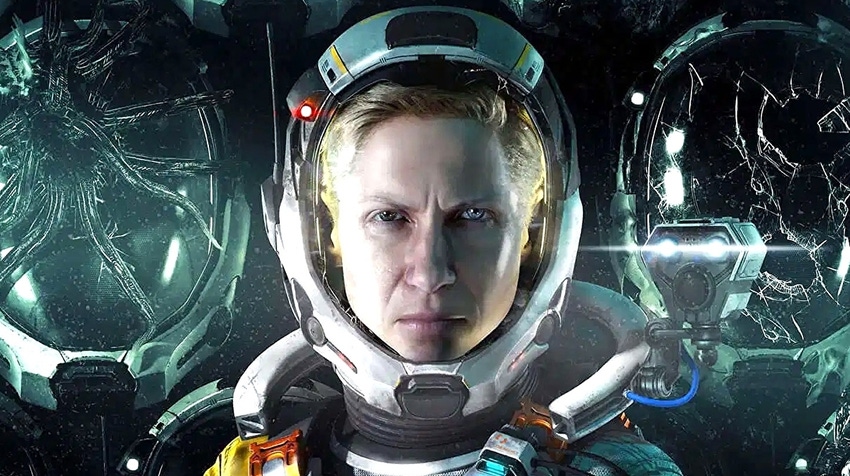Returnal was a huge pivot for Housemarque. Here's how the team navigated its development.

If not for the surprise hit Returnal, the debut of the PlayStation 5 may have been a lot less eventful. The dark, cosmic-horror bullet hell game was not necessarily one of the most anticipated for the new console, but audiences have been taken with it nonetheless.
During GDC 2022, Housemarque’s Harry Krueger gave a talk about the game’s development, detailing its successes and failures while providing a roadmap for how the studio transformed itself to rise to its many new challenges. Amid new tech, a bigger team, and several design concepts that they’d never worked with before, the process was marked by both technical and cultural hurdles, from conceptualizing the game and forming its design pillars to prototyping and executing it while making the transition from 2D to 3D along the way. The ensuing discussion is an insightful look at how they brought together all their ideas while managing scope, messaging, and their most essential design values.
The talk began with Krueger explaining what the goals and design values of Housemarque were as they began development on Returnal. "If this [slide] feels a bit like immediate sensory overload, then I think that's the perfect introduction to Housemarque by itself," Krueger jokes, noting that the studio's motto is "gameplay is king." For them, that goal entails satisfying the player's immediacy with razor-sharp controls and a commitment to technical excellence, including "uncompromising" 60 frames-per-second, and "spectacular" VFX and presentation. But it also includes an emphasis on mystery and depth in both the narrative and gameplay, a focus on "bullet ballet" (their spin on the "bullet hell" genre), and addictive replayability, to be "designed in a way that keeps pulling you back."
.png/?width=700&auto=webp&quality=80&disable=upscale)
Returnal was the culmination of several different ideas and suggestions over the years. The creative seed, as Krueger outlines, was first planted in November 2014 during an internal pitching session. He suggested a dark fantasy-meets-cyberpunk open-world game called Cyber Kingdom, to which, he says, he was "practically laughed out of the room." He returned to work on Nex Machina but kept the idea in mind, hoping to someday make a third-person arcade adventure game. The following year, as they decided what project to work on and pitch to Sony next, the "dark planet" concept for the game and Returnal's primary characteristics as a dark sci-fi cosmic horror roguelike were defined.
In 2017 prototyping started with a skeleton crew of 5, followed by the full development kick-off in August 2017 with a team of 25 people, at which point Krueger joined. "It's important to note that with dark planet, the concept, it started out platform-agnostic and camera-agnostic as well. So at the time, we would have been happy to make it as a top-down game, you know, but after a bit of discussion back and forth, we thought this is our opportunity, we have a really strong concept, let's shoot for the stars and maybe land on a hostile alien planet." By the game's April 2020 release, the team had expanded from 25 to 80.
One of the first things Krueger did once he came on the project was establish its goals. They knew that they wanted to bring the established brand of Housemarque "explosive action and cool tech" to a triple-A third-person game, which to Krueger meant, "Awesome Arcade Action." And they knew they wanted to explore roguelike elements primarily to enforce replayability and depth while having, for the first time ever in their games, a mystery-driven narrative aiming to haunt the player.
"If you want to test a developer's character, give them a big budget."
The "Hellavator Pitch" was very simple: the player crashes down on a hostile alien planet with no memory of how they got there, quickly succumbing to the cosmic horrors therein. But upon their death, instead of finding peace, they reawaken just moments before the inevitable crash landing, trapped in an endless cycle where even death is no escape. "You're a rat trapped in an ever-changing maze, like some cosmic forces are toying with your sanity." The aim was that with each cycle the player completed, they would slowly make progress and learn more about the planet's ancient history, ever moving forward in hopes of breaking that cycle. This description became not only the pitch for recruitment and onboarding but also the basis of their internally produced mock-up trailer, which wound up being the announcement trailer later on.
The sources of inspiration for Returnal, says Krueger, have been discussed at length: cosmic horror, Lovecraft and David Lynch, but what drove and inspired it most was the concept of The Call of the Void, that urge to jump when you're at a great height, or you're near a ledge. The lead character Selene, he explains, is, for better or worse, answering that call in a way that is almost self-destructive--hence her dangerous interactions with the local fauna or her tendency to jump into holes or body-shaped crevasses.
This was Krueger's first attempt at writing a game story, and as such, he says, it was a reflection of himself. His second child was born during the development of Returnal and thus, the theme of "never having enough time" was often on his mind. "So I started just following that kind of line of thinking and thought, what would be the ultimate cosmic joke for somebody obsessed with time? Well, what if you trapped them in a time loop? Now they have all the time in the world." It became his own personal call of the void, he explains, an exploration of how far he was willing to go in order to make no compromises, because compromises lead to mediocrity. Find your connection with your main character, Krueger says, as this was his way to understand and connect with the game's protagonist, Selene.
Finding Selene
Selene's characterization was a reverse engineering process; the team started with the tone of the story and then chose to make her a very determined person to explain her dynamism in the face of cosmic horror.
There were initial challenges in "selling" the game as a triple-A experience; Krueger says there are different expectations in terms of pacing and cinematic storytelling, and realism. The inconsistent tone between the game's dark story and "bright" action was flagged as a disconnect, and the more elegant and clutter-free aspects of the game, as well as the bullet hell-based combat, were elements that Krueger had to defend. Altogether the concept was ambitious and "uncharted territory," which made it a tough package. He and the team, he says, learned to embrace uncertainty. Creative work is always clouded with doubt, and sometimes you won't be able to see the forest for the trees. "Sometimes, the cohesion actually comes from just commitment and execution of that vision."
Solidifying The Vision
So as development began, Krueger collected raw material using mood boards, collecting images, and organizing ideas with tools like Mind Maps and Pinterest. He was often guided by the "rule of cool," that is, how something would make the players feel. "When you have so much creative freedom, it's like you need to create your own constraints." Don't overthink it by chasing the false promise of innovation at every corner, he says, as it is a time sink and doesn't always pay off. Follow the process of distillation: throw it all out there, then break it down. What you discard is as just as important as what you keep. But also keep in mind that it's a collaborative process.
For example, the visual style of Returnal did not properly gel until art director Ilmari Kumpunen came on and could see that "four-fifths" of what they'd already suggested just wasn't working. That, and the addition of narrative director Greg Loudon, as well as bringing on the programmers and art and design teams, etc., helped "the bandwidth open up" and collectively solidify their creative vision.
Solidifying The Pillars
The team formed several cornerstones to refer to as they made creative decisions. Following their core motto of "gameplay is king," they sought to combine roguelike variation with a compelling narrative and Housemarque's signature explosive action. For them, this meant "invisible camera and controls"--"the best ones are the ones you never know are there"-- and "depth without complexity," that is, a deep experience that didn't overload the players, one that followed the arcade mantra of “easy to pick up, hard to master."
Krueger also uses the term “knife’s edge engagement" to describe how they desired for players to achieve a sense of flow and commitment to their run while accumulating stakes--the better you play, the more you have to lose. Along with “bullet ballet,” that is, a classic bullet hell style gameplay, this would inform Returnal’s combat, with a commitment to embracing simplicity as part of the formula. While brainstorming is addictive, Kruger says, good design is subtractive. Aim to do ordinary things extraordinarily well. It’s more important to spend resources on the quality of execution rather than increasingly complex, elaborate ideas.
Roguelike Variation
Housemarque's goal in pursuing roguelike variation for Returnal was rooted in their desire to "create memorable player stories." The team wanted to create “describable runs and meaningful variation,” focusing on things that would create memories and differing experiences. This was achieved in part through the game’s high stakes permadeath, “steep zero to hero progression,” and the team’s uncharacteristic embracing of randomness, a factor that deviated from their previously highly-structured titles. By trying to get the RNG under control, they found they were not achieving a solid roguelike feel, so they reversed course, allowing the variations to “breathe."
“In many ways, we favored adaptability over player agency. So it's not about what the player can do in the world; it's more about how can they adapt to what this crazy world is throwing at them, with a new thought that was a much more interesting way of framing the roguelike content.” This forced adaption would also help achieve their design goals of forcing the player to truly master the mechanics, rather than rely on memorization. Their "roguevania formula" would also focus on curiosity-driven gameplay, while delivering a permanent sense of progression that would impact their toolkit and world.
Compelling Narrative
This was a new area of focus for Housemarque, and they aimed to haunt the player by embracing ambiguity and mystery. “The questions are more important and interesting than the answers,” explains Krueger. Anticipation releases dopamine and often is more exciting than gratification, so their goal was to create that dopamine. They also made it a rule to “defy definitive interpretation,” even inside the team. “I feel,” Krueger says, "if you give even the team a definitive answer, even unconsciously, it will find its way into the game.” And their goal was more to keep the players asking questions. They found the best way to do that is to support and entertain those questions rather than give an answer.
Keeping the narrative compelling meant also keeping their commitment to making narrative and gameplay “inseparable and intertwined," supporting them with the game’s difficulty level and atmosphere, among other features. Krueger also says he wanted the cut scenes to feel like a milestone of progress, part of an “opt-in” narrative that is lean and unintrusive to the player, which in the case of Returnal included optional content like audio logs. Worldbuilding took precedent over exposition.
Replayability
"The One Ring To Rule Them All," the factor that binds together their three pillars, says Krueger, is replayability. “The more you play, the more all these things are strengthened.” One core question the team asked themselves throughout the process was, “will this be fun after 100 times?” As a general rule, he says, things that are only fun once should only be experienced once. And keep it challenging, he advises. “I think it’s important to trust the player…If you don't flirt with despair sometimes, you're not going to have a feeling of triumph." Trust in the player can also be summarized as "play to learn, not learn to play.” Leaving room to let players figure things out creates a safe experimentation space that makes the experience feel more personal. And above all, he says, emphasize the joy of playing--the player should be able to pick up the controller and have fun even if they don’t care about the story.
Prototyping and Finding the Fun
The rest of Krueger’s talk focused on some of the specific design challenges of Returnal and how they were addressed in each scenario, talking about how they were able to channel those struggles into new modes of thinking as they transitioned from the studio's character use of 2D to 3D. This perspective switch was a challenge for them in particular because they didn’t feel they had any direct examples to model themselves after. They had to account for the removal of the player’s intuitive spatial awareness in 2D--that is, there are far more visual considerations in 3D. It was also difficult to maintain the arcade field in a 3D space, as they needed the action to feel fast and responsive. For the most part, Krueger feels they were successful in addressing those concerns, primarily by keeping things simple and consistent, with gameplay and responsiveness as the main focus, though technical compromises on animations and realism had to be made.
As he wrapped up, Krueger also opened up about what did not make it to the final version of the game, from NPCs, to “helper droids” and an alternate “dark” narrative path that would have seen Selene turn into a deformed creature. The game was initially planned to have 13 different biomes, which were eventually whittled down to six, while the initial number of bosses, and one specifically called The Machine, were also reduced. Features like multiplayer, photomode, and the suspend/resume button had to be pushed to the DLC release. “We had to pick our battles,” Krueger says.
Creating Chaos Through Chaos
Reflecting on the game’s development, Krueger cites the growth of the team as the biggest challenge, likening the process to growing from a garage band to a well-trained orchestra. But there were also multiple other hurdles: the game’s new risky concept, the team’s first foray into 3D, its procedural roguelike structure, and their first time telling an in-depth story. They were also using a new engine, Unreal Engine 4, and developing for a new platform, the PlayStation 5. And they were doing so during COVID, with an expanding team and accompanying growing pains, new production processes, and culture shifts.
In terms of what went wrong, Krueger says developing on a new engine led to instability and regressions. “It's not an exaggeration to say that about half of the game's development time, the game was actually unplayable. It was broken.” The “Sisphyean” process was often two steps forward, one step back, with the team breaking things constantly because of a lack of familiarity with the new engine. This led to a constant accumulation of debt as pre-production bled into production. Naivety and inexperience were also a factor, as they severely underestimated the complexity of the project, heavily affecting those who had limited bandwidth, as multiple people were spread thin. The rapidly growing team also meant their workflow was often reactive rather than proactive, as they were constantly adapting to technical changes, cultural changes, and messaging. When you have so many new people coming on to a team, it’s "critical to have a unified voice" between management, production, directors, and leadership, one that can unite rather than divide the team, Krueger says.
As for what went right, Krueger cites great teamwork and the ability of everyone on the team to punch above their weight and rise to the challenges. He also says working as a Sony ExDev partner, and with remote tech talent agency CoDev helped bring the game to scope. The game itself was well-received, and its creative DNA survived the transition to 3D, while as their first foray into big leagues set a strong foundation for the future. And they were able to create enough lasting appeal that people are still playing the game.
Key Takeaways
To wrap up the key lessons Housemarque learned during Returnal, Krueger says to defend your vision--compromising leads to mediocrity. Remember who you are and build on your strengths. But also, don't overthink it, and don't be a prisoner of your dream. Listen to the game and the team.
Pick your battles--know when to delegate and let go and empower the team. You can't fit the whole game in your own head.
Embrace uncertainty-- creative work is always filled with doubt. Perfect plans only exist in hindsight. There is no silver bullet to development. Your resolve will be tested.
Organization-- fix your messaging. Keep it unified, simple, and consistent. Avoid creating a buffet of values.
Above all, remember the game is the Boss. Keep it stable and playable at all times, and test frequently.
Read more about:
FeaturesAbout the Author(s)
You May Also Like

